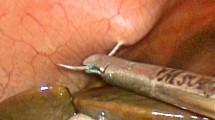Abstract
Purpose
Cholangiography is often crucial for establishing the definitive diagnosis in infants with prolonged jaundice. Here, we describe our protocol of using the two-hole laparoscopic technique and discuss its benefits.
Methods
144 consecutive patients with suspected biliary atresia were included in this retrospective study. A 5-mm umbilical port is introduced for a 30° laparoscope. An additional 5-mm trocar was inserted at right subcostal incision. A liver biopsy was performed first if needed. The fundus of gallbladder was then exteriorized through the incision of the working port after pneumoperitoneum was released and a catheter is inserted into the gallbladder for cholangiography.
Results
The average duration of operation was 34 min (range 20–55 min). Laparoscopic cholangiography failed in 21 cases (14.6%) where atrophic gallbladder was found and BA was confirmed by subsequent laparotomy. For the remaining 123 cases, biliary atresia were diagnosed in 88 (71.5%), biliary hypoplasia in 14 (11.4%), and cholestasis in 21 (17.1%), respectively. There was no bleeding or any other complications intraoperatively.
Conclusion
The technique of laparoscopic cholecystocholangiography is simple, safe and efficient. It can provide an accurate diagnosis. Furthermore, for patients without biliary atresia, unnecessary laparotomy can be avoided.








Similar content being viewed by others
References
Hirsig J, Rickham PP (1980) Early differential diagnosis between neonatal hepatitis and biliary atresia. J Pediatr Surg 15:13–15
Dehghani SM, Haghighat M, Imanieh MH, Geramizadeh B (2006) Comparison of different diagnostic methods in infants with cholestasis. World J Gastroenterol 12:5893–5896
Nose S, Hasegawa T, Soh H, Sasaki T, Kimura T, Fukuzawa M (2005) Laparoscopic cholecystocholangiography as an effective alternative exploratory laparotomy for the differentiation of biliary atresia. Surg Today 35:925–928
Okazaki T, Miyano G, Yamataka A, Kobayashi H, Koga H, Lane GJ, Miyano T (2006) Diagnostic laparoscopy-assisted cholangiography in infants with prolonged jaundice. Pediatr Surg Int 22:140–143
Hay SA, Soliman HE, Sherif HM, Abdelrahman AH, Kabesh AA, Hamza AF (2000) Neonatal jaundice: the role of laparoscopy. J Pediatr Surg 35:1706–1709
Senyuz OF, Yesildag E, Emir H, Tekant G, Bozkurt P, Sarimurat N, Soylet Y (2001) Diagnostic laparoscopy in prolonged jaundice. J Pediatr Surg 36:463–465
Abeş M, Sarihan H, Cobanoğlu U (2003) A treatment for biliary hypoplasia: tube cholecystostomy and irrigation. Eur J Pediatr Surg 13:21–25
Park WH, Choi SO, Lee HJ, Kim SP, Zeon SK, Lee SL (1997) A new diagnostic approach to biliary atresia with emphasis on the ultrasonographic triangular cord sign: comparison of ultrasonography, hepatobiliary scintigraphy, and liver needle biopsy in the evaluation of infantile cholestasis. J Pediatr Surg 32:1555–1559
Gupta DK, Srinivas M, Bajpai M (2001) AIIMS clinical score: a reliable aid to distinguish neonatal hepatitis from extra hepatic biliary atresia. Indian J Pediatr 68:605–608
Lin WY, Lin CC, Changlai SP, Shen YY, Wang SJ (1997) Comparison technetium of Tc-99m disofenin cholescintigraphy with ultrasonography in the differentiation of biliary atresia from other forms of neonatal jaundice. Pediatr Surg Int 12:30–33
Leape LL, Ramenofsky ML (1977) Laparoscopy in infants and children. J Pediatr Surg 12:929–938
Azuma T, Nakamura T, Nakahira M, Harumoto K, Nakaoka T, Moriuchi T (2003) Pre-operative ultrasonographic diagnosis of biliary atresia—with reference to the presence or absence of the extrahepatic bile duct. Pediatr Surg Int 19:475–477
Kotb MA, Kotb A, Sheba MF, El Koofy NM, El-Karaksy HM, Abdel-Kahlik MK, Abdalla A, El-Regal ME, Warda R, Mostafa H, Karjoo M, A-Kader HH (2001) Evaluation of the triangular cord sign in the diagnosis of biliary atresia. Pediatrics 108:416–420
Schier F, Waldschmidt J (1990) Experience with laparoscopy for the evaluation of cholestasis in newborns. Surg Endosc 4:13–14
Acknowledgments
This study was supported by grants from National Science and Technology Infrastructure Program, 11th five-year plan, NO 2006BAI05A06.
Author information
Authors and Affiliations
Corresponding author
Additional information
L. Huang and W. Wang contributed equally to this work.
Rights and permissions
About this article
Cite this article
Huang, L., Wang, W., Liu, G. et al. Laparoscopic cholecystocholangiography for diagnosis of prolonged jaundice in infants, experience of 144 cases. Pediatr Surg Int 26, 711–715 (2010). https://doi.org/10.1007/s00383-010-2598-1
Accepted:
Published:
Issue Date:
DOI: https://doi.org/10.1007/s00383-010-2598-1




